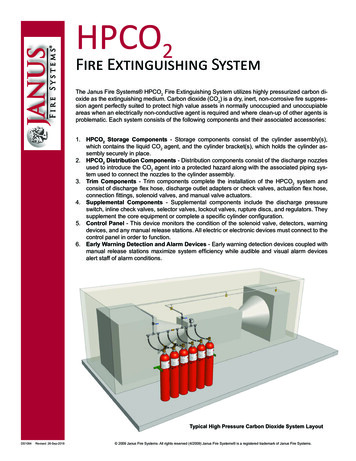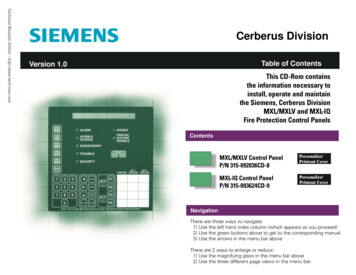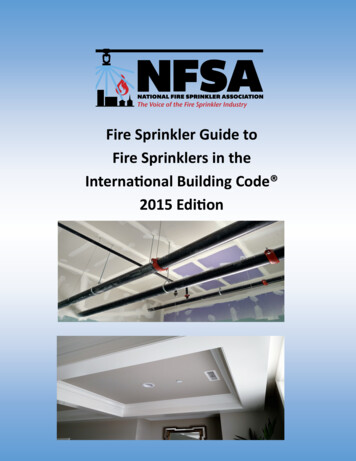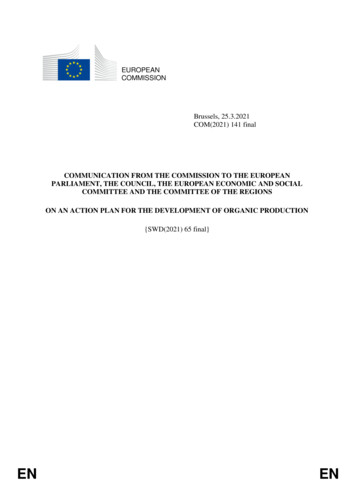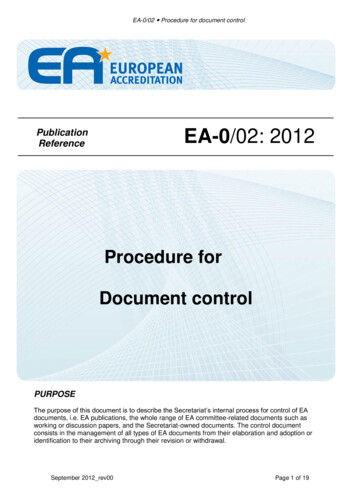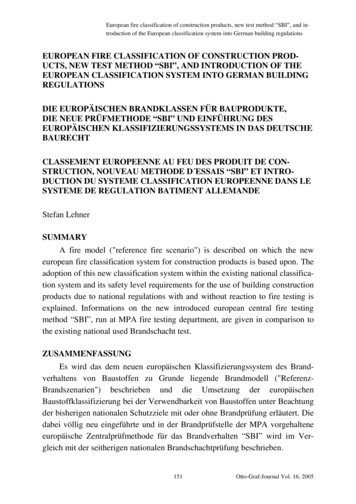
Transcription
European fire classification of construction products, new test method “SBI”, and introduction of the European classification system into German building regulationsEUROPEAN FIRE CLASSIFICATION OF CONSTRUCTION PRODUCTS, NEW TEST METHOD “SBI”, AND INTRODUCTION OF THEEUROPEAN CLASSIFICATION SYSTEM INTO GERMAN BUILDINGREGULATIONSDIE EUROPÄISCHEN BRANDKLASSEN FÜR BAUPRODUKTE,DIE NEUE PRÜFMETHODE “SBI” UND EINFÜHRUNG DESEUROPÄISCHEN KLASSIFIZIERUNGSSYSTEMS IN DAS DEUTSCHEBAURECHTCLASSEMENT EUROPEENNE AU FEU DES PRODUIT DE CONSTRUCTION, NOUVEAU METHODE D ESSAIS “SBI” ET INTRODUCTION DU SYSTEME CLASSIFICATION EUROPEENNE DANS LESYSTEME DE REGULATION BATIMENT ALLEMANDEStefan LehnerSUMMARYA fire model ("reference fire scenario") is described on which the neweuropean fire classification system for construction products is based upon. Theadoption of this new classification system within the existing national classification system and its safety level requirements for the use of building constructionproducts due to national regulations with and without reaction to fire testing isexplained. Informations on the new introduced european central fire testingmethod “SBI”, run at MPA fire testing department, are given in comparison tothe existing national used Brandschacht test.ZUSAMMENFASSUNGEs wird das dem neuen europäischen Klassifizierungssystem des Brandverhaltens von Baustoffen zu Grunde liegende Brandmodell ("ReferenzBrandszenarien") beschrieben und die Umsetzung der europäischenBaustoffklassifizierung bei der Verwendbarkeit von Baustoffen unter Beachtungder bisherigen nationalen Schutzziele mit oder ohne Brandprüfung erläutert. Diedabei völlig neu eingeführte und in der Brandprüfstelle der MPA vorgehalteneeuropäische Zentralprüfmethode für das Brandverhalten “SBI” wird im Vergleich mit der seitherigen nationalen Brandschachtprüfung beschrieben.151Otto-Graf-Journal Vol. 16, 2005
S. LEHNERRESUMENous décrivons ici d’une part le nouveau système de classement au feu européen des matériaux de construction basé sur le modèle de réaction au feu(«scénario de référence de réaction au feu»), d’autre part la transcription de laclassification européenne dans l’utilisation des matériaux de construction dans lecadre des objectifs de prévention nationaux – avec ou sans test au feu – actuellement en vigueur. Nous décrivons la méthode centrale européenne « SBI »de test au feu, nouvellement introduite et présentée au département de contrôlede réaction au feu de MPA, en comparaison avec la méthode de test «Brandschacht» jusqu’à présent en vigueur au niveau national.KEYWORDS:1Approval, Bauregelliste, building product directive, classification, commission decision, CWFT, fire growth, fire scenario, fixing & mounting, flame spread, flashover, ignitability, non combustibility, SBI, smokeINTRODUCTIONProtection against fire hazard and assessment of reaction to fire as well asfire resistance is a basic presumption when planning and erecting buildings andis therefore an imperative requirement from both, national and EC regulations,given e.g. in the construction products directive (CPD). Assessment of reactionto fire solely is possible on basis of a prescriptive fire model and resulting firetest methods. Reaction to fire for building products historically is given by classification within national standards such as DIN 4102. The new reaction to fireclassification system for building products according to EN 13501-1, set up bythe European Commission, now requires reaction to fire assessment on basis ofnew introduced fire test methods, especially the new “central” test method,“SBI”. These new european reaction to fire classes have to be set in relation tothe existing national classification system and its legal requirements, thus rendering possible the use of the products due to national building regulations.152Otto-Graf-Journal Vol. 16, 2005
European fire classification of construction products, new test method “SBI”, and introduction of the European classification system into German building regulations2EUROPEAN FIRE CLASSIFICATION SYSTEM2.1 Fire scenario – Fire modelEuropean commission Construction Products Directive (CPD) 89/106 givesthe basic provisions for limitation of the generation and spread of fire and smokewithin the building, one of them being the limitation of the building products contribution to a fully developed fire.To render possible the estimation and limitation of the building products contribution to a fire, the implementation of a fire classification system wasrecommended for the description of their reaction to fire. The classificationsystem itself is not included in the Construction Products Directive but has beenpublished first time within Commission Decision 94/611/EG [1] and finally waspublicated with Commission Decision 2000/147/EG [2].The 7 fire classes for building products laid down in the Commission Decision are specified in the standard EN 13501-1 "Fire classification of constructionproducts and building elements" [3]. These european fire classes in principle aswell cover the requirements of the as yet existing 5 national German reaction tofire classes according to DIN 4102 [4].Classification is a means to consider the construction product s contribution to the generation and spread of fire and smoke within the room of origin orin a given area. A simplifying assumption is made to apply the same classification to different orientations and geometrics and to product types other thanroom surface products. Products are generally considered in relation to their enduse application.For all building products, this classification is based upon fire models("reference scenarios"), the principal validity of which has been shown fromvarious fire desasters or results from real large scale fire tests. The latter onesare based on the consideration of a fire, initiated in a room, which can grow andeventually reach flashover. This scenario includes three fire situations corresponding to three stages in the development of a fire (Fig. 1) : First stage includes initiation of the fire by ignition of a building product,with a small flame, within a limited area of the product.153Otto-Graf-Journal Vol. 16, 2005
S. LEHNER Second stage adresses fire growth eventually reaching final flashover situation with heat release 1 MW to 2 MW and temperature levels of 800 1200 C.This stage generally is simulated for building products by a single burningitem in the corner of a room, creating a heat flux onto the adjacent surfaceswithin the room. For floorings, a fire is seen to grow in the room of its origin, creating a heat flux on the floorings in an adjacent room or corridor,through a door opening. Smoke development and smoke density have aswell to be taken in account. In the post-flashover phase all combustible buiding products present finallyare contributing to the fire load (fully developed fire).Temp.post-flashover phasefully developed firecoolinggrowing firephaseignitioninitiation of the fireflash-overtimeFig. 1 : fire model (after Troitzsch [5], Beard [6] et.al.)Different classes address exposure of the product to the fire at differentstages of the fire development in the reference scenario.According to EN 13501-1, the relation between fire classes for buildingproducts excluding floorings (Table 1), and for floorings ("fl", Table 2), and theabove shown reference fire scenario generally is described as follows:154Otto-Graf-Journal Vol. 16, 2005
European fire classification of construction products, new test method “SBI”, and introduction of the European classification system into German building regulationsTable 1: Relationship between the classes and the reference fire scenariosfor building products excluding floorings acc. to EN 13501-1Euroclassclassificationacc. to DIN4102contribution to fire / aspired safety levelFProducts for which no reaction to fire performances are determinedor which cannot be classified in one of the classes A1, A2 , B , C ,D, E.EProducts capable of resisting, for a short period, a small flame attack without substantial flame spread.DProducts satisfying criteria for class E and capable of resisting, fora longer period, a small flame attack without substantial flamespread. In addition, they are also capable of undergoing thermalattack by a single burning item with sufficiently delayed and limited heat release.CAs class D but satisfying more stringent requirements. Additionallyunder the thermal attack by a single burning item they have limitedlateral spread of flame.BAs class C but satisfying more stringent requirements.A2Satisfying the same criteria as class B for the SBI-test according toEN 13823. In addition, under conditions of a fully developed firethese products will not significantly contribute to the fire load andfire growth.A2A1Class A1 products will not contribute in any stage of the fire including the fully developed fire. For that reason they are assumedto be capable of satisfying automatically all requirements of alllower classes.A1B3B2B1Additional classifications for smoke production:s3: No limitation of smoke production requireds2: The total smoke production as well as the ratio of increase in smoke production are limiteds1: More stringent criteria than s2 are satisfiedAdditional classifications for flaming droplets/particles:d2: No limitationd1: No flaming droplets/particles persisting longer than a given time allowedd0: No flaming droplets/particles are allowed155Otto-Graf-Journal Vol. 16, 2005
S. LEHNERTable 2: Relationship between the classes and the reference fire scenariosfor floorings acc. to EN 13501-1Euroclassclassificationacc. to DIN 4102contribution to fire / aspired safety levelFflProducts for which no reaction to fire performances are determined or which cannot be classified in one of the classes A1fl,A2 fl, B fl, C fl, D fl, E fl.E flProducts capable of resisting a small flame attack without substantial flame spread.D flProducts satisfying E fl and in addition capable of resisting, fora certain period, a heat flux.C flAs class D fl but satisfying more stringent requirements.B flAs class C fl, but satisfying more stringent requirements.A2 flSatisfying the same requirements as class B fl relating to heatflux. In addition, under conditions of a fully developed firethese products will not significantly contribute to the fire loadand fire growth.A2A1 flClass A1 products will not contribute in any stage of the fireincluding the fully developed fire. For that reason they are assumed to be capable of satisfying automatically all requirements of all lower classes.A1B3B2B1Additional classifications for smoke production:s2: No limits1: The total smoke production is limited2.2 Testing and classification of reaction to fire of building productsaccording to european standards (EN)The 7 reaction to fire classes A1, A2, B, C, D, E, F for construction building products/floorings, published in the above noted commission decision, aregiven in standard EN 13501-1 "Fire classification of construction products andbuilding elements – Part 1: Classification using test data from reaction to firetests". These european fire classes principally as well cover the yet existing 5German building product s classes (Baustoffklassen) A1, A2, B1, B2, B3 according to DIN 4102.For assessment of reaction to fire, as far as possible test methods had beenchoosen based on already existing international standards (ISO) [7].156Otto-Graf-Journal Vol. 16, 2005
European fire classification of construction products, new test method “SBI”, and introduction of the European classification system into German building regulationsSome of the european fire testing methods are mainly comparable to theexisting German fire tests in terms of testing and sample mounting procedures,thus giving sufficient equivalence in test results. A greater number of productsis therefore assumed to meet at least the existing national safety levels whenclassified into euro-class E (ignitability test/“Kleinbrennerprüfung“, EN ISO11925-2 [8] ) or classes A1/A2 (non-combustibility test EN ISO 1182 [9] andheat of combustion test EN ISO 1716 [10]). The test method for floorings (ENISO 9239-1 [11]) substantially compares to DIN 4102-14 [12, 13], too.Reaction to fire tests for classification purposes of building constructionproducts according to EN 13501-1, are therefore generally possible to be performed, based on european standardized fire test methods, since all of the testingstandards had allready been published. Nevertheless, the problem still is existing, that for some of the fire tests according to european standard test methods,to a great extend still the rules are missing on how samples are to be prepared, orfixed and mounted for testing purposes, with regard to the general requirementof consideration the end use application as given in the commission decisionsand the classification standard (“fixing & mounting”). The same is true for thestill wanting guidance on the validity of test results for variations in one or moreof the product properties and/or intended end use applications (“extended application“). Another still unsolved problem adresses the yet completely missingeuropean rules for testing the smouldering hazards in fires, which are fire safetyclassification demand in some member states, e.g. Germany. The introduction ofthese rules and guidances, into the corresponding technical product specifications such as harmonized product (EN) standards, European Technical ApprovalGuidlines (ETAG) etc. or additional test directions (recommendations, technicalguidance papers etc.) are but unconditional presumptions beforehand the neweuroclass system can totally be adopted.157Otto-Graf-Journal Vol. 16, 2005
S. LEHNER3NEW EUROPEAN “CENTRAL” TEST METHOD3.1 “SBI“ according to EN 13823As was said before, for assessment of reaction to fire, as far as possible testmethods had been choosen based on already existing international standards(ISO). Both, the national and the new european classification, are but partlybased on different test methods, therefore a direct comparability between bothsystems is not given. Proof of correct relation of the classification limits, andcomparability of european to national reaction to fire classification, solely canbe given by direct comparison of test results on a product by product method.Especially for assessment of the “central” european classes (B, C, D), a totally new test method had been established: the so called SBI-Test (SingleBurning Item acc. to EN 13823 : 2002-02 : Reaction to fire tests for buildingproducts. Building products excluding foorings exposed to the thermal attack bya single burning item [14] ). The original aim of this standard has been, comparable to the well known German Brandschacht-test according to DIN 4102-1/-15[4, 15], to determine flame spread under the attack of a single burnig item suchas e.g. a burning paper basket in a room corner. Conception, test arrangement,and test performance, however, are fundamenally different to the existing national Brandschacht test method. Thus, direct comparabilty definately is notgiven at all.Figures 2 a through c show -somewhat simplified- main construction partsof the SBI test arrangement.158Otto-Graf-Journal Vol. 16, 2005
European fire classification of construction products, new test method “SBI”, and introduction of the European classification system into German building regulationsa : test room (housing) - schematicb : fixed frame with hood, collector,exhaust duct with measurement sectionc : trolley(courtesy Fire Testing Technology Ltd., Charlwoods Road, East Grinstead, West Sussex, UK)Fig. 2 a - c : SBI – test apparatus159Otto-Graf-Journal Vol. 16, 2005
S. LEHNER3.2 Comparison between both “central” test methodsThe comparison between the both “central” test methods, the existing national Brandschacht acc. to DIN 4102 and the new european testing method SBIacc. to EN 13823 (Table 3), shows the main parameter flame spread now is replaced by the measurement of heat release being the essential european classification criterion.Table 3: Brandschacht compared to SBI testBrandschacht - DIN 4102szenario/modelSBI - EN 13823fire single burning item in a room corner(Paperbasket)requirementsingle burning item in a room cornerflame spread not substantial outside sufficient retarded and limtedprimary areaheat release heat release limtedlimited lateral flame spreadsmoke - temperature- (density)smoke - rateflaming droplets/particlesflaming droplets/particles(smouldering)-test period10 min20 minparameterresidual lengthFIGRA (heat release)smokegas-temperatureSMOGRA (smoke rate)smokegas-densityLFS (lateral flame spread)flaming droplets/particlesflaming droplets/particlesadditional:- development release160Otto-Graf-Journal Vol. 16, 2005
European fire classification of construction products, new test method “SBI”, and introduction of the European classification system into German building regulations3.3 SBI testing facilties at MPA-Otto-Graf-Institute fire departmentThese differences require re-development of most of the common usedbuilding products in terms of fire safety performance. Thus, it could be foreseen,that most of the building products on the market would be subject to new-/retesting.MPA-Otto-Graf-Institute fire department was able to install an SBI-test apparatus and now is in a position to provide this central european fire test methodfor about 80% of the european approved building products. The SBI-test apparatus requires more room, extent, test period, and sample size etc. than the Brandschachtprüfung, and putting it into operation made necessary a new fire testinglaboratory and the installation of an expensive smoke cleaning system which isrequired by legislation.In combination with the whole of all the other european fire test methodsavailable at MPA-Otto-Graf-Institute fire department, all of the fire tests forbulding products and floorings necessary for both, national and european testing,are now provided.Figure 3a shows the SBI-test apparatus run at MPA-Otto-Graf-Institute firedepartment and Figure 3b shows a real SBI test on slab material.Fig. 3a : MPA-Otto-Graf-Institute fire department test laboratory with SBI–test apparatus161Otto-Graf-Journal Vol. 16, 2005
S. LEHNERFig. 3b : SBI-test on slab material4REACTION TO FIRE CLASSIFICATION WITHOUT TESTINGIn a further European Commission descision 96/603/EG [16], those building pro-ducts are listed which are classified into categories A1/A1fl -no contribution to a fire in any stage including the fully developed fire- without testing.These products, classified A1 from their well known reaction to fire behaviour (“deemed to satisfy“), are listed in an annex to this descision. The list covers, amongst others: concete, mineral fibres, foamglass, fibrecement, lime, metals (iron, steel, copper, zinc, aluminum, lead), gypsum, mortars with inorganicbinders (rendering and plastering mortars and floor screeds with one or moreinorganic binders, as are e.g. cement, lime, masonry mortar or gypsum), clay(bricks, slabs, chimney claddings), calcium-silicate materials, natural stone andslate materials, glass, ceramics (including glass-ceramics, and glazed or unglazed extruded products).Nevertheless, none of the listed products may contain more than 1 % perweight or volume (whatever is the lower value has to be taken into account) ofhomogeniously dispersed organic content. Products, which are made by laminat162Otto-Graf-Journal Vol. 16, 2005
European fire classification of construction products, new test method “SBI”, and introduction of the European classification system into German building regulationsing one or more of the listed materials, are classified into class A1 without testing, if the laminating glue does not exceed 0.1 % per weight or volume.Products with one or more organic layers or containing not homogeniouslydispersed organic material, cannot be classified based on this
11925-2 [8] ) or classes A1/A2 (non-combustibility test EN ISO 1182 [9] and heat of combustion test EN ISO 1716 [10]). The test method for floorings (EN ISO 9239-1 [11]) substantially compares to DIN 4102-14 [12, 13], too. Reaction to fire tests for classificat
